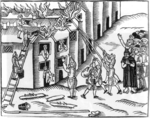Tiverton Museum of Mid Devon Life
Art museums and galleries in DevonGrade II listed buildings in DevonGrade II listed museum buildingsLocal museums in DevonMuseums established in 1960 ... and 3 more
Tiverton, DevonTransport museums in EnglandUse British English from September 2017

The Tiverton Museum of Mid Devon Life is a local history museum in Tiverton, Devon, England, to the southwest of Gotham House. It features various exhibits relating to the social and economic history of the Mid Devon region, one of the most popular being a steam locomotive known as the "Tivvy Bumper". Founded in 1960 and initially located in rooms in a local pub, the museum is now housed in a Grade II listed former National School.
Excerpt from the Wikipedia article Tiverton Museum of Mid Devon Life (License: CC BY-SA 3.0, Authors, Images).Tiverton Museum of Mid Devon Life
St Andrew Street, Mid Devon
Geographical coordinates (GPS) Address External links Nearby Places Show on map
Geographical coordinates (GPS)
| Latitude | Longitude |
|---|---|
| N 50.901 ° | E -3.488 ° |
Address
Tiverton Museum of Mid Devon Life
St Andrew Street
EX16 6FA Mid Devon
England, United Kingdom
Open on Google Maps









